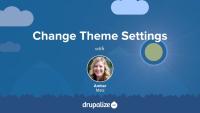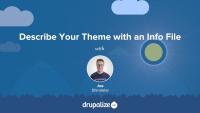Dig into Drupal 8 at DrupalCon
Blog postDrupalCon is almost here and it’s time to start filling out your schedule. There’s a lot to do and see (not to mention eating lots of great New Orleans food!), so we definitely recommend having at least a rough game plan for how to use your time. Here’s a look at things you should be considering, especially if you are looking to take away a lot of Drupal 8 knowledge.
What's New in Drupal 8.1.0
Blog postDrupal 8.1.0 was released on April 20th. There are a few things that are exciting about this release; in particular the 2 new experimental modules BigPipe and Drupal Migrate UI.
Learn Views in Drupal 8
Blog postOne of the big changes in Drupal 8 is that Views, the most popular contributed module in Drupal 7, is now included as part of core. Learning Views is a key component of learning to build Drupal sites. Aside from having this tool built in core now, the beauty of this new feature is that it is almost identical to Views in Drupal 7. You can get started site-building with Views in Drupal 8 without waiting for any fancy version-specific instructions.
Customizing the available regions in your theme is one of the first things you'll do when creating your own themes. Doing so gives you complete control over where content is displayed on the page, and the markup involved. Adding regions to a theme is a two-step process that involves editing your theme's THEMENAME.info.yml file and updating your page.html.twig file.
In this tutorial we'll:
- Declare one or more new regions in our themes THEMENAME.info.yml file.
- Output the content of those regions in our theme via the page.html.twig file.
By the end of this tutorial you should be able to add or edit the regions a theme provides. Also, you'll ensure that blocks placed into regions are displayed by outputting the regions in the page template.
Some, but not all, themes come with administrator-configurable settings that you can change through the UI. These might allow you to upload your own logo, choose between a couple of different pre-defined layouts, or turn features of a theme on or off. In this tutorial we’ll look at where you can find these theme settings if they exist, and how to go about changing them.
Meet Drupal Site Builder Scott Wilkinson
Blog postIn this Drupalize.Me interview, we interview Scott Wilkinson, a builder of Drupal sites that solve problems for his freelance clientele. This interview is part of an ongoing series where we talk with a variety of people in the Drupal community about the work they do. Each interview focuses on a particular Drupal role and this interview with Scott focuses the site builder role, filled by a person who builds Drupal sites by expertly piecing together and configuring modules, themes, and settings.
Drupal has a few handy settings you can tweak to make developing themes a little more intuitive and a lot more awesome. In this tutorial, we'll practice manually setting up our environment for theme development by:
- Disabling some caches
- Turning off CSS and JS aggregation
- Turning on the Twig debug service
By the end of this tutorial, you'll have practiced setting up your environment for theme development.
Themes and modules can alter the list of theme hook suggestions in order to add new ones, remove existing ones, or reorder the list. This powerful feature allows for the definition of custom logic in your application that can tell Drupal to use different templates based on your own unique needs. You might for example; use a different page template for authenticated users, or a custom block template for someone's birthday.
In this tutorial we'll cover:
- Adding new theme hook suggestions from a theme using
hook_theme_suggestions_HOOK_alter() - Altering the list of theme hook suggestions
- Removing theme hook suggestions
- Reordering the list of theme hook suggestions
Info files, aka THEMENAME.info.yml files, provide Drupal with metadata about your theme, the features it supports, and the regions that it defines. All themes are required to have a THEMENAME.info.yml file, and creating one is generally the first step you'll take when creating a new theme.
In this tutorial we'll:
- Create a new .info.yml file and define a new theme
- Review the required key/value pairs of an .info.yml file
- Enable our new theme in the Drupal UI
By the end of this tutorial you'll be able start a new theme by creating the required *.info.yml file and better understand its contents.
Upgrade Status: Phases 1 and 2 Complete
Blog postIt has been a few months since we started our site upgrade, and I wanted to give an update on our progress. We are a small team of three, who manage the site and create most of the videos, so needless to say we've gotten a bit waylaid on our schedule. We've also had quite a bit of fun distraction with our Lullabot company retreat (which was sooo fun!) and DrupalCon Munich (which was amazing). So, while we're not as far as we wanted to be, we have gotten a good chunk of work started, and we're through Phases 1 and 2!
Theme developers often need to add or remove classes and other attributes from an HTML tag. Template files handle this with a special Attributes object that contains the attributes and their values, as well as a handful of powerful methods to help manage these attributes.
In this tutorial we’ll cover:
- Adding/removing classes from elements in a Twig template
- The attributes object
- Examples of common tasks using various helper methods on the attributes object
One important aspect of theme administration is the configuration of global and theme-specific settings. In this tutorial, you will learn where theme settings are configured in Drupal's administrative interface, the difference between global and theme-specific settings, and what each global setting refers to on a base installation of Drupal with a custom theme installed.
One of the primary ways that modules extend Drupal is by adding dynamic pages with content generated by application-specific logic. This tutorial looks at Drupal's process of handling a user's request and transforming it into a complete web page. We'll answer questions like:
- How does Drupal use Symfony's HttpKernel to process requests?
- How do user-configured blocks and the theme layer contribute to the page's content and appearance?
- What is the role of routes, controllers, and responses in this process?
In this tutorial, we'll:
- Follow the journey of a user request from URL to an HTML response in Drupal.
- Define the role of routes, controllers, and responses in Drupal's request handling.
- See how blocks and the theme layer contribute to the final output of a Drupal page.
By the end of this tutorial, you should be able to describe Drupal's request flow, understand the interaction of its key components in building a page, and appreciate the modular architecture that drives Drupal's flexibility.
Meet Front-End Developer Tiffany Tse
Blog postIn this Drupalize.Me interview, we talked with Tiffany Tse, front-end developer, Creative Director for Coldfront Labs, Inc., and instructor at Alongquin College. This interview is part of an ongoing series where we talk with a variety of people in the Drupal community about the work they do. Each interview focuses on a particular Drupal role and this interview with Tiffany focuses on the front-end developer and themer role.
In this Drupalize.Me interview, we talk with Jon Peck and David Diers, two engineers from Four Kitchens, about their Drupal experience. This interview is part of an ongoing series where we talk with a variety of people in the Drupal community about the work they do. Each interview focuses on a particular Drupal role, and this interview with Four Kitchens focuses on the developer role.
A Guide to Drupal 8 at DrupalCon Austin
Blog postDrupalCon Austin is rapidly approaching and the big question on my mind is: What Drupal 8 sessions do I need to put on my radar? To figure that out, I've mined the schedule for Drupal 8 related talks and events and organized them a bit to help me – and hopefully you – find the Drupal 8 sessions not to be missed.
Drupal 8 External Libraries Galore!
Blog postThere are lots of goodies coming in Drupal 8. A lot of work has gone into bring Drupal up to modern web standards. In addition to digging into Drupal-specific problems, a lot of work has gone into removing some of the custom overhead we have by incorporating a number of external libraries—that is, code that other communities have created and maintain, and does not live on Drupal.org. Adding external libraries means that we are working with these other open source communities to maintain our code, and that lets us focus on the Drupalisms we need, instead of re-inventing the wheel all over the place. This is the biggest growth for exernal libraries that we've ever seen, and I decided to take a look at what we have in core now.



